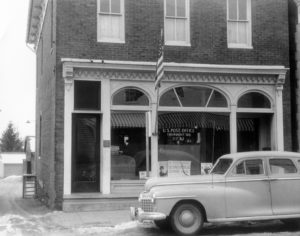By James Rada, Jr.
Safecrackers Go After the Thurmont Post Office
Late one Saturday night in 1916, two men walked up to the Thurmont Post Office, which at the time was located on the first floor of the Masonic building on East Main Street. They walked casually, alone on the street. They paused beneath the street light that shined down directly in front of the post office and then moved to the front door.
They looked through the window into the post office and saw no one inside, which is not surprising since it was around 1:30 a.m. on a Saturday night. A light had been left turned on in the office, though, so they had to be sure. With practiced precision, they forced open the front door and slipped inside, shutting the door behind them so as not to draw attention.
They then forced the door between the lobby and the work room. This is where they found what they had been seeking… the post office’s large safe. It had been installed in the building when the post office moved from its former location in the Thurmont Bank Building at the center of town. Postmaster Joseph Gernand was also a harness maker. His shop had been where the post office was, but he moved up to the second floor of the building to make room for the post office.
“Two other safes, smaller in size, were also in the room, and both contained papers valuable to the postmaster and clerks,” the Catoctin Clarion reported.
The safecrackers placed nitroglycerine at vulnerable points on both the main safe and one of the smaller ones. A small wire was attached to the nitroglycerine and run across the room to the side door that opened onto the alley. “By punching a chip from a panel in the door, the wire was passed out and into the alley and attached to a battery and the charge set off,” the Clarion reported.
The explosion was loud, but the men did not panic. It was expected. Time was now a premium. The people whom the explosion had awakened would be groggy, and it would take them a bit to realize what they had heard. They would call the sheriff who would investigate, but then it would take him time to track down where the explosion had come from. The bank would be the most obvious location, and it would be inspected first. In fact, many residents didn’t even report the explosion, even though they heard it, because they “all thought it to be someone putting off dynamite crackers and paid no further attention to the matter,” according to the newspaper.
The thieves moved back into the bank. The door from the two safes had been blown clear of the safes themselves. The smaller door had flown twenty feet across the room and struck the wall near the ceiling. The door of the larger safe was heavier. It had blown free of the safe and fallen over.
Papers and books were strewn around the room. “Soap, which was used in closing the cracks around the door, was found pasted against the carriers’ desks, and dust from the fire proof material was scattered over the entire room,” the newspaper reported. Shrapnel from the explosion had punctured the ceiling in at least a dozen places.
They couldn’t get what they had hoped for. Inside the large safe was a strongbox where cash and stamps were stored. The explosion hadn’t harmed the strongbox “and the thieves likely thought it was unwise to tarry and prepare to blow this after the noise made by the first two explosions,” the Clarion reported. The second safe had contained nothing of value. Although the third safe had been unlocked, they made away with only $1.25 that was in the safe.
The next morning, M. J. Albaugh, who lived next door to the Masonic building, was walking along the street when he noticed that the front door to the post office was ajar. He reported the break-in to Postmaster Gernand and Robert Tyson. Both men returned to investigate and found the damage in the workroom.
The Postmaster Inspector arrived in the afternoon and reviewed the books. He found that all of the money and stamps in the safe were accounted for.
The Masons covered the damage to the buildings and the safes, while the postmaster had to reimburse the $1.25 that had been used to purchase American Red Cross stamps. No mail was apparently disturbed.
A piece of iron belonging to the freight rigging of a freight car and wire for the explosives were the only things that the thieves apparently left behind. “There was no indication that blankets or other material had been used to deaden the sound of the explosion, and it is the question to many whether the work was done by experts or men yet new at the business.”
The case remained unsolved. However, the thieves may have been part of the other three safecracking robberies in the region that the Clarion reported on in early 1916.

The Thurmont Post Office on East Main Street as it appeared in the 1950s on East Main Street.
Photos Courtesy of Thurmontimages.com

